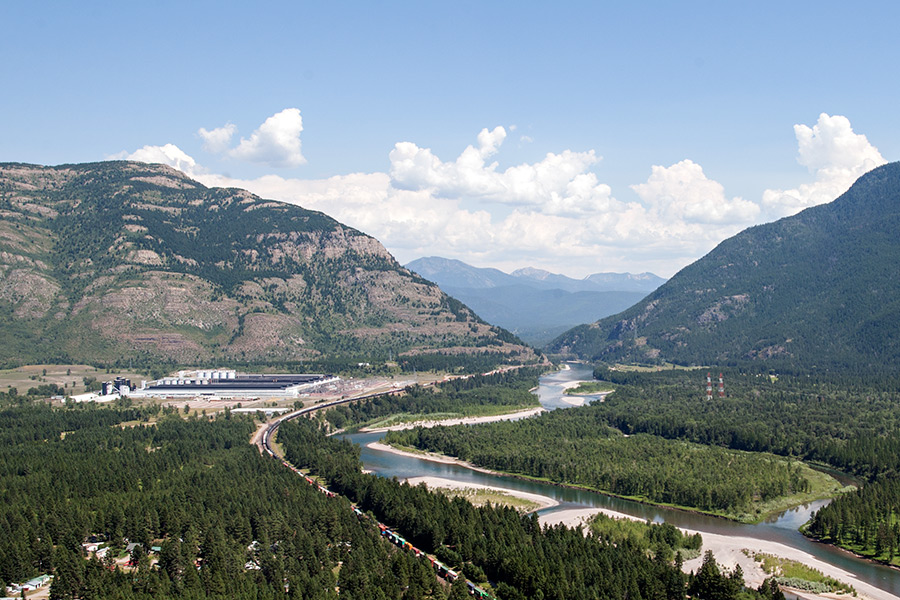Anita Bailey has been a realtor in Mineral County for more than a decade, helping people find their own slice of Big Sky Country. For the most part, the hunt for a home in the Clark Fork Valley is straightforward, but Bailey says at least a few times a year someone will suddenly back out of a deal after learning about a little piece of local history: the Flat Creek Iron Mountain Mine and Mill.
Located just north of Superior, the mine operated sporadically from 1909 until 1953, harvesting silver, gold, lead, copper and zinc ore from the earth. Even though it was only active for a total of 27 years, its impacts have far outlasted its lifespan. An Environmental Protection Agency investigation in the 2000s found elevated concentrations of lead, arsenic, antimony, cadmium and manganese throughout the community. In September 2009, the EPA added the mine and town to the Superfund program’s National Priorities List.
While most of the town itself has been completely cleansed, Bailey said some potential buyers couldn’t get over the fact that the area was once contaminated.
“Most of the time, when people do get the information, they’re OK with it,” Bailey said. “But there are some people who just won’t buy here when they find out about the Superfund because of the associated stigma.”
That dilemma can be found in many communities across Montana with Superfund designations. According to the EPA, there are 17 Superfund projects in the state, including the recently added Columbia Falls Aluminum Company site.
Jim Davison, executive director of the Anaconda Local Development Corporation, said a Superfund designation is a double-edged sword. On one hand, putting a site on the National Priorities List holds companies responsible and improves the environment, Davison said. But on the other hand, some developers and companies don’t want to deal with the stringent environmental regulations that follow.
The Anaconda Copper Mining Company mined ore around Butte and Anaconda for more than a century. The Anaconda smelter was closed in 1980. Three years later, the EPA placed it and more than 300 square miles of land on the south end of the Deer Lodge Valley on the National Priorities List. Thirty-three years later, the cleanup continues. As a result, Davison said the area has lost out on some major developments in recent years.
“Some companies don’t want to touch this area with a 10-foot pole, even after the cleanup, because of the regulations,” he said.
“This Superfund has been with us for 30 years and it’s had a significant impact on the community,” Davison continued. “There have been some positive things that have happened, but there has also been some negatives.”
One of the positives in Anaconda has been the construction of a NorthWestern Energy power plant. Davison said he hopes as time goes on, and more people learn about the Superfund and what it entails, the stigma will fade.
In The Dalles, Oregon, the 305-acre Martin-Marietta Aluminum Co. plant was closed in 1987 and designated a Superfund site soon afterward. Nearly 30 years later, much of the site has been cleaned up and delisted. Part of it was recently sold to a private company and is ready for industrial development, according to Kathy Ursprung with the Port of The Dalles. However, some small pieces of the site remained fenced-off and are still monitored for contamination.
Another success story is found near Bonner and the Milltown Dam. After the site was designated a Superfund, the dam on the Clark Fork was removed along with more than 6.6 million cubic yards of contaminated sediment. Today, the area along the river is a state park.
As state and federal officials considered whether to list CFAC as a Superfund, many in the community worried about the implications. Some residents pointed to an example two hours away in Libby, home to one of the largest environmental cleanups in American history. The EPA added Libby and the surrounding area to the Superfund list in 2002 after it was discovered that much of the community was contaminated with cancer-causing asbestos.
Mark Peck, a native of Libby and current Lincoln County commissioner, said the Libby Superfund is a lot different than the recently designated Columbia Falls site. For starters, the Libby site encompasses an entire town, whereas the CFAC site only covers 960 acres.
“It’s a lot more personal here in Libby because the contamination is literally in people’s homes,” Peck said.
Peck said it’s important that local residents and elected officials ask questions of federal officials and get as much information as they can about Superfund.
“If I could give one piece of advice, it’s to make sure everyone understands what’s happening, to go in with your eyes wide open and to stay engaged with the process,” he said. “The Superfund program is a good one and it’s there to protect the public. But there are ramifications as well that are long term and are difficult to undo.”
